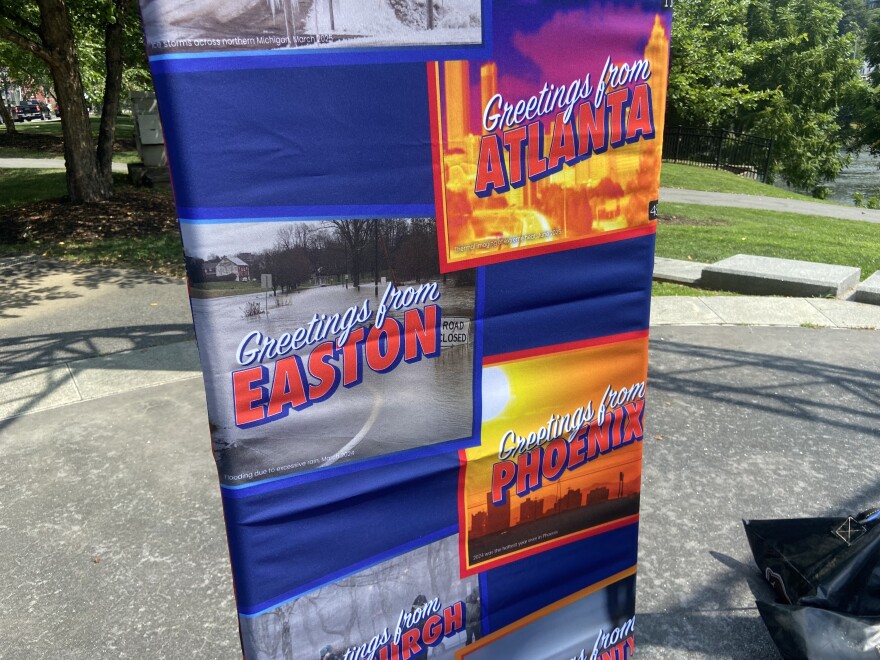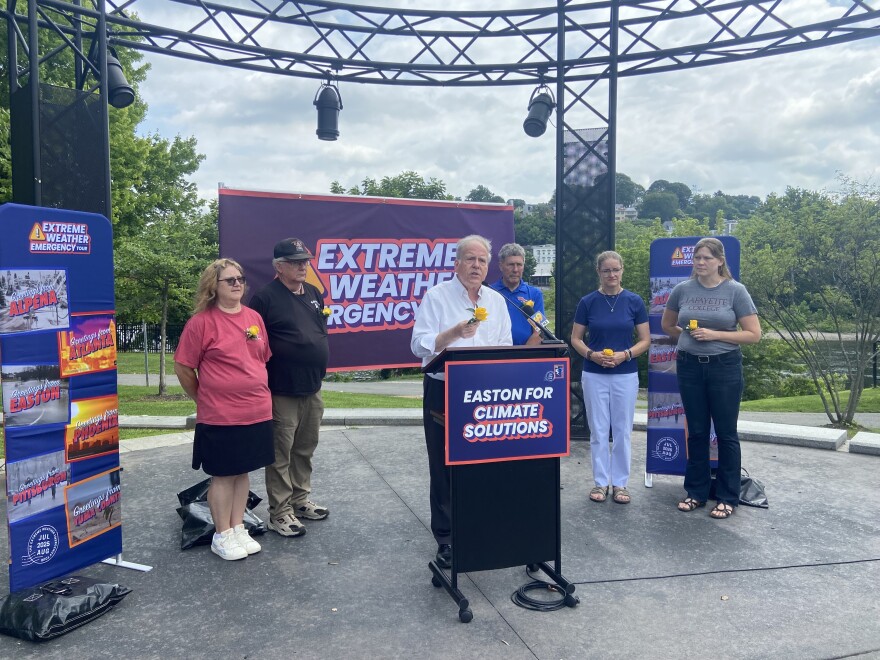EASTON, Pa. — The city is no stranger to flooding, and, officials said, it’s getting worse.
“Higher temperatures for prolonged periods of time, with repeated heavy downpours of rain, are causing flooding and ongoing stormwater problems,” state Rep. Robert Freeman, D-Northampton, said.
“These heavy downpours are increasing nationally, and here in the Lehigh Valley. They are driven by warmer air, holding more water vapor in the atmosphere.
"Easton has seen flooding go from a once in a three- to four-year event to becoming something which is an annual event.”
Freeman and a handful of local leaders gathered with environmental experts and advocates, Thursday at Scott Park to advocate for climate change mitigation and to criticize federal cuts to weather emergency research and programs.
The event, part of Climate Action Campaign’s Extreme Weather Emergency Tour, centered on how extreme weather, exacerbated by climate change, has deadly consequences.
"Over the last few decades, our biggest storms have been getting bigger, and these storms will continue to grow into the future.”Christa Kelleher, a hydrologist and assistant professor at Lafayette College
“Our conclusively warming climate is making extreme events like flooding, as well as droughts as well as hurricanes, even worse,” Christa Kelleher, a hydrologist and assistant professor at Lafayette College, said.
“Here in the northeast, one of the strongest climate change signals that we see is that extreme precipitation events are increasing in size.
"Over the last few decades, our biggest storms have been getting bigger, and these storms will continue to grow into the future.”

‘Flooding more likely and extreme’
Larger storms, combined with more impervious surface cover from development, means extreme flooding can happen more often, Kelleher said.
“These larger events cost us more, not only in terms of dollars, but, sadly, as we've seen very recently, in terms of lives,” she said.
Thursday's event came just shy of three weeks after devastating flooding in Texas killed at least 135 people.
Officials held yellow roses as it opened with a moment of silence in remembrance of the victims.
“What is most worrying to me about the current moment is that the things that we need to combat flooding and other extreme events... are being taken away from us."Christa Kelleher, a hydrologist and assistant professor at Lafayette College
“What is most worrying to me about the current moment is that the things that we need to combat flooding and other extreme events — more data, more observational stations, more experts, more warning systems, greater funding for resilient infrastructure — are being taken away from us,” Kelleher said.
“I cannot stress to you enough how worrying it is that we are seeing the defunding of federal agencies that help us respond to extreme events and the removal of clean air protections, which has direct implications for pollution and climate change.”
Federal efforts under President Donald Trump and the U.S. Department of Government Efficiency have stymied efforts to keep residents safe, and rebuild after weather emergencies, officials argued.
The administration has cut hundreds of jobs at the National Weather Service. In April, federal officials announced the end of FEMA’s Building Resilient Infrastructure and Communities program.
In response, Pennsylvania and a slew of other states, are suing the administration.
‘Funding needs to be restored'
The Valley, and the city, have seen several instances of flash flooding over the past two decades.
Freeman recalled heavy rainfalls in January and March of last year that caused flooding and road closures.
He also remembered excessive rain caused by Tropical Storm Debbie that August, causing thousands of residents to lose power.
“Our current infrastructure makes flooding more likely and extreme, cutting communities off from vital services and causing extensive damage."State Rep. Robert Freeman, D-Northampton
“Last month, our region had almost 7 inches of rainfall," Freeman said. "Our the last three months saw more than 11 inches of rainfall.
“Our current infrastructure makes flooding more likely and extreme, cutting communities off from vital services and causing extensive damage.
"Upgrading our infrastructure to be more resilient can mitigate stormwater damage, saving lives and money.”
While there’s state-level legislation proposed to support clean energy and promote renewable energy, “funding needs to be restored to address stormwater infrastructure improvements and wetlands restoration,” he said.
“Having our emergency disaster and weather-related agencies fully functional and able to respond to extreme weather events is also very critical,” he said.
“Addressing climate change will address the underlying causes of our extreme weather events and serve to mitigate the severity of our weather patterns and storm water and flooding problems.”
‘No one can do that for us but us’
Flooding, hurricanes and droughts are the new normal for the Valley, Kelleher said.
“We can't change that,” Kelleher said. “Instead, the part that we have control over is what we choose to do about it and what we choose to advocate for.
Sustained investment in local infrastructure and protecting wetlands are key, she said.
“We need forward-looking planning that keeps the addition of impervious surfaces far from the floodplain, and, like the new proposed million-square-foot warehouse that's just a stone's throw from Bushkill Creek," she said.
"We must demand change, because increasing our resiliency to extreme events is something that will impact all of our lives now and into the future."
During a Palmer Township Board of Supervisors meeting Tuesday, residents spoke against the million-square-foot Easton Commerce Park warehouse.
Rachel Hogan Carr, executive director at the Nurture Nature Center, said the center has worked to educate and prepare residents and community leaders for flooding events.
It was founded after devastating flooding in 2004, 2005 and 2006, she said. Over the past decade, it has held about 90 focus groups in flood prone communities across the country.
“One of the large takeaways that happens right now is that we realize when an event like Texas flooding happens that all of the technology in the world is only as valuable as it is once it gets into the hands of people who need it."Rachel Hogan Carr, executive director at the Nurture Nature Center
“One of the large takeaways that happens right now is that we realize when an event like Texas flooding happens that all of the technology in the world is only as valuable as it is once it gets into the hands of people who need it,” Hogan Carr said.
“And if it can't get to the hands of people who need it, that's the gap we need to fill.”
In addition to supporting technology and forecasting, “we really need to take ownership at a local level,” she said.
Questions to consider include: What happens if we get a flood worse than we had in 2004, 2005 and 2006? What happens if it's worse than what happened in 1955?
Are we prepared for that? What steps are we going to take, and what properties are going to be affected, and how are we notifying residents, and what is our strategy for that?
“This is really the challenge now, is to invest in our infrastructure at the technology level, to really strengthen our emergency preparedness response at our county level emergency managers and local level emergency managers," she said.
"And then ourselves to fill the gap in the middle of community readiness and preparedness.
“And no one can do that for us but us.”


